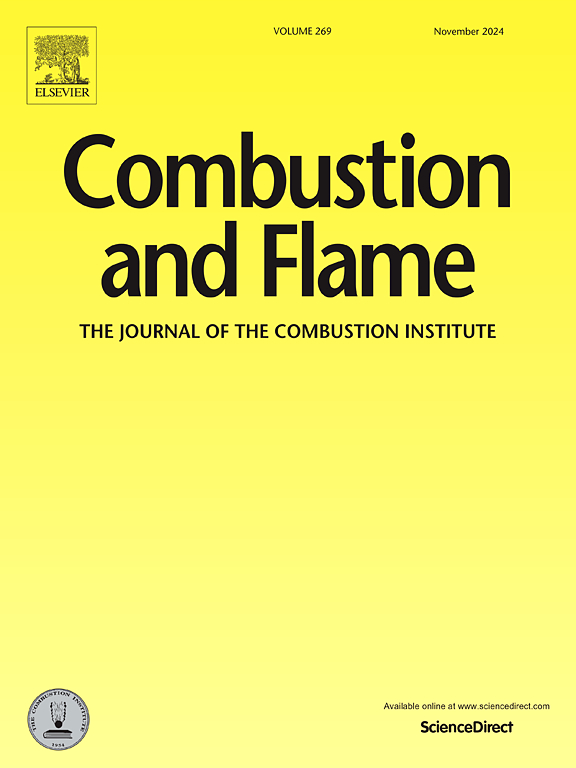Super adiabatic combustion of carbon-free and carbon-containing fuels
IF 5.8
2区 工程技术
Q2 ENERGY & FUELS
引用次数: 0
Abstract
The present work provides a new perspective on super adiabatic combustion (SAC) of fuel/air mixtures involving methane, ethane, propane, butane, heptane, iso-octane, 1-hexene, toluene, ammonia, and hydrogen. The simulations cover the temperature range of 1200–2000 K, initial pressures of 1–50 atm, and equivalence ratios of 0.5–2.0. The detailed chemical kinetic mechanism C3MechV3.5 has been used for 0D simulations in a constant volume batch reactor with Cantera 2.5.0. It has been found that SAC can be observed in lean, stoichiometric, and rich mixtures. While all hydrocarbon fuels show a strong correlation with each other, hydrogen and ammonia produce a significantly different pattern of SAC compared to carbon-containing fuels. Two reasons for super adiabaticity have been identified: (1) the super-equilibrium of H2O, NO, and/or CO2 due to the time delay between their production and consumption, and (2) the energy intensive dissociation reactions of, e.g., N2, H2O, and CO2. Furthermore, it has been found that a super-equilibrium of H2O always indicates super adiabaticity. For paraffinic hydrocarbons, since SAC is primarily governed by C0-C1 and NOx reactions, the low and intermediate temperature auto-ignition chemistry involving alkyl-peroxyl radical and the poly-aromatic hydrocarbon (PAH) reactions do not influence SAC.
Novelty and Significance Statement
As of now, super adiabatic combustion (SAC) has been shown mainly for rich premixed hydrocarbon/oxidizer mixtures. In the present work, SAC is reported for a wide range of equivalence ratios covering lean, stoichiometric, and rich mixtures of different classes of hydrocarbons in air. This work also presents a comprehensive analysis of SAC characteristics. Furthermore, the SAC of hydrocarbon fuels is compared with that of carbon-free fuels ammonia and hydrogen. For the first time in the literature, the following key facts about SAC are now reported: (a) there are different trends in SAC of hydrocarbon/air mixtures at different initial pressures and temperatures, (b) ammonia and hydrogen have significantly different trends, and (c) for linear and branched paraffins, SAC can be correlated with the number of carbon atoms in the fuel molecule. In this work, it has been pointed out that there is experimental data in the literature where the super-equilibrium of the water molecule has been observed during auto-ignition, but not linked to SAC. Therefore, the results presented in this work establishes SAC as an important topic in modern combustion chemistry research.
无碳和含碳燃料的超绝热燃烧
本研究为研究甲烷、乙烷、丙烷、丁烷、庚烷、异辛烷、1-己烯、甲苯、氨和氢等燃料/空气混合物的超绝热燃烧提供了一个新的视角。模拟温度范围为1200 ~ 2000 K,初始压力为1 ~ 50 atm,等效比为0.5 ~ 2.0。详细的化学动力学机理C3MechV3.5用Cantera 2.5.0在定容间歇式反应器中进行了0D模拟。已经发现SAC可以在稀薄的、化学计量的和丰富的混合物中观察到。虽然所有碳氢燃料都表现出很强的相关性,但与含碳燃料相比,氢和氨产生的SAC模式明显不同。已经确定了超绝热的两个原因:(1)H2O、NO和/或CO2的超平衡是由于它们的产生和消耗之间的时间延迟造成的;(2)能量密集的解离反应,例如N2、H2O和CO2。此外,还发现H2O的超平衡总是表示超绝热。对于石蜡烃,由于SAC主要由C0-C1和NOx反应控制,因此涉及烷基-过氧自由基和多芳烃(PAH)反应的低温和中低温自燃化学不影响SAC。目前,超绝热燃烧主要表现在富含烃类/氧化剂的预混混合物中。在目前的工作中,SAC报告了广泛的等效比,包括空气中不同类别碳氢化合物的稀薄、化学计量和丰富混合物。本文还对SAC的特征进行了全面分析。此外,还比较了含烃燃料与无碳燃料氨和氢的SAC。文献中首次报道了以下关于SAC的关键事实:(a)在不同的初始压力和温度下,烃/空气混合物的SAC有不同的趋势,(b)氨和氢的SAC有显著不同的趋势,(c)对于线性和支链烷烃,SAC可以与燃料分子中的碳原子数相关。在这项工作中,已经指出在文献中有实验数据,其中观察到水分子的超平衡在自燃过程中,但没有链接到SAC。因此,本工作的结果确立了SAC在现代燃烧化学研究中的重要地位。
本文章由计算机程序翻译,如有差异,请以英文原文为准。
求助全文
约1分钟内获得全文
求助全文
来源期刊

Combustion and Flame
工程技术-工程:化工
CiteScore
9.50
自引率
20.50%
发文量
631
审稿时长
3.8 months
期刊介绍:
The mission of the journal is to publish high quality work from experimental, theoretical, and computational investigations on the fundamentals of combustion phenomena and closely allied matters. While submissions in all pertinent areas are welcomed, past and recent focus of the journal has been on:
Development and validation of reaction kinetics, reduction of reaction mechanisms and modeling of combustion systems, including:
Conventional, alternative and surrogate fuels;
Pollutants;
Particulate and aerosol formation and abatement;
Heterogeneous processes.
Experimental, theoretical, and computational studies of laminar and turbulent combustion phenomena, including:
Premixed and non-premixed flames;
Ignition and extinction phenomena;
Flame propagation;
Flame structure;
Instabilities and swirl;
Flame spread;
Multi-phase reactants.
Advances in diagnostic and computational methods in combustion, including:
Measurement and simulation of scalar and vector properties;
Novel techniques;
State-of-the art applications.
Fundamental investigations of combustion technologies and systems, including:
Internal combustion engines;
Gas turbines;
Small- and large-scale stationary combustion and power generation;
Catalytic combustion;
Combustion synthesis;
Combustion under extreme conditions;
New concepts.
 求助内容:
求助内容: 应助结果提醒方式:
应助结果提醒方式:


